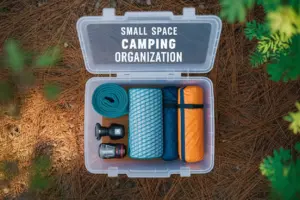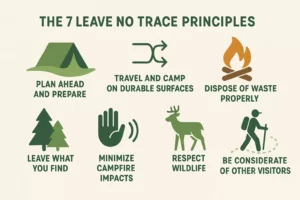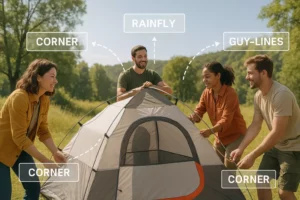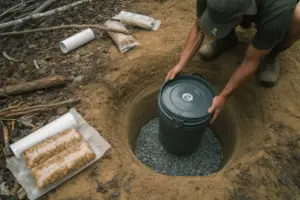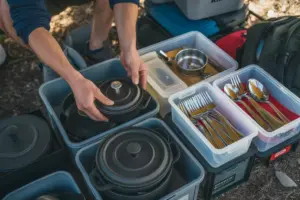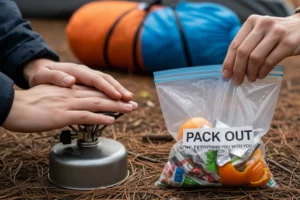Building Your First Aid Kit for Camping: Essential Guide for Safe Outdoor Adventures
When a fellow camper suffered a deep cut from a camp knife at a remote backcountry site, the difference between a well-stocked first aid kit and basic bandages became crystal clear. In the wilderness, where professional medical help can be hours away, your first aid kit becomes your lifeline. 🏕️
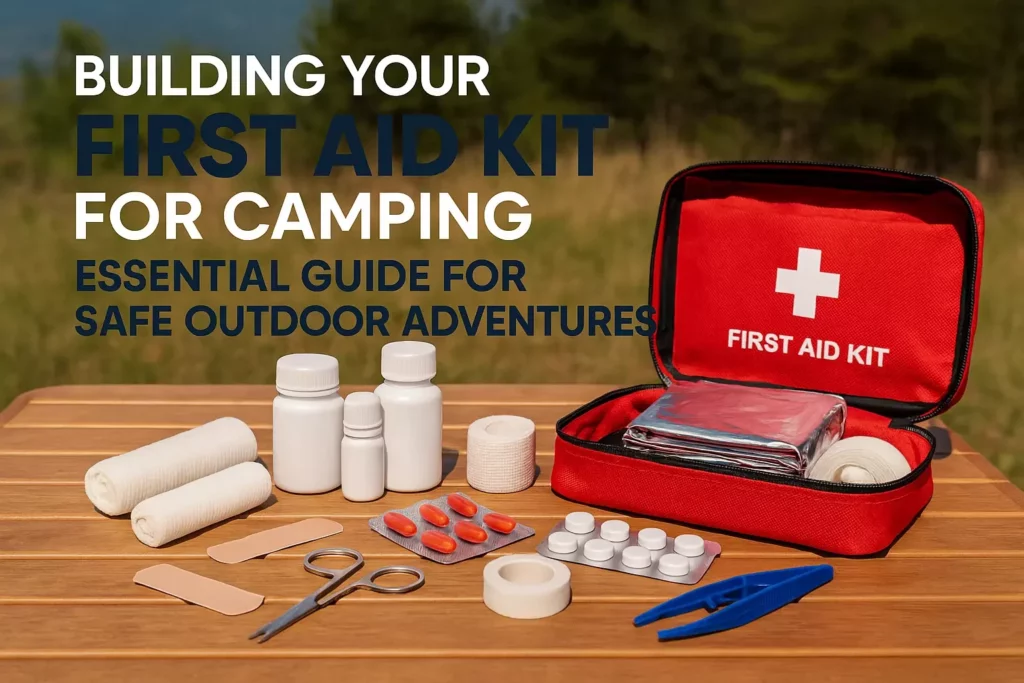
Whether you’re planning a weekend car camping trip or embarking on a multi-day backpacking adventure, having the right medical supplies can mean the difference between a minor inconvenience and a dangerous emergency. Building a comprehensive camping first aid kit requires careful consideration of your specific needs, trip duration, group size, and the remoteness of your destination.
Key Takeaways
- Customize your kit based on trip length, group size, and medical conditions of participants
- Include both basic supplies (bandages, antiseptic) and emergency items (emergency blanket, whistle)
- Organize supplies in waterproof containers with clear labeling for quick access during emergencies
- Check and refresh your kit regularly, replacing expired medications and used supplies
- Know how to use everything in your kit through basic first aid training before heading outdoors
Understanding First Aid Kit Basics
Why Standard Kits Fall Short
Most store-bought first aid kits contain minimal supplies designed for minor cuts and scrapes. While these might work for day trips to local parks, camping presents unique challenges that require specialized preparation. Remote locations, varying weather conditions, and limited evacuation options demand a more comprehensive approach to medical preparedness.
Risk Assessment for Camping
Before building your kit, consider the specific risks associated with your camping style:
Car Camping Risks:
- Burns from campfires and cooking equipment
- Cuts from knives and camp tools
- Insect bites and stings
- Minor sprains from uneven terrain
Backpacking Risks:
- Dehydration and heat exhaustion
- Hypothermia in cold conditions
- Blisters and foot injuries
- Falls and more serious trauma
- Getting lost or stranded
Understanding these risks helps prioritize which supplies deserve precious space and weight in your pack.
Essential First Aid Supplies for Every Camping Kit
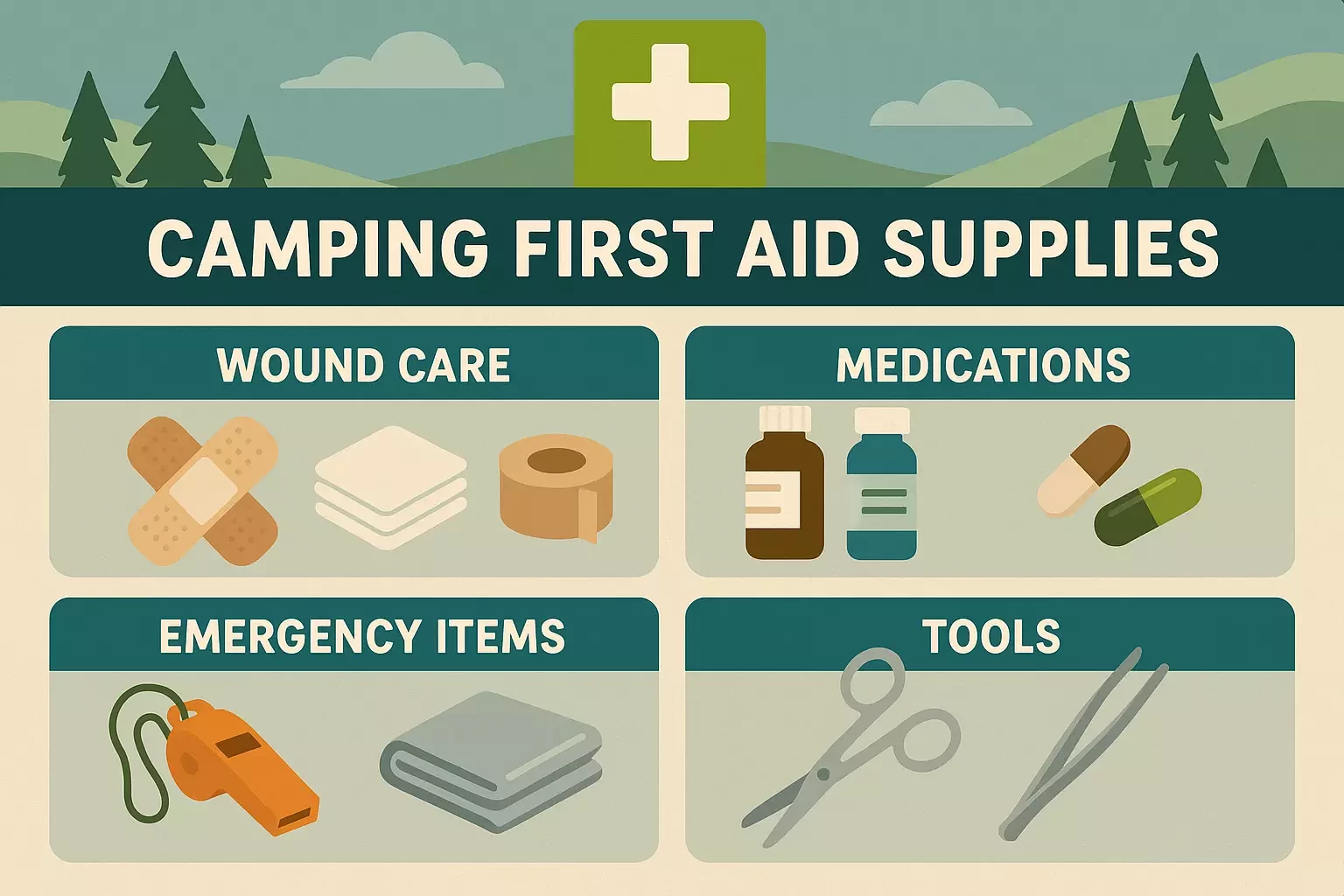
Wound Care Fundamentals
Bandages and Dressings:
- Adhesive bandages (various sizes) – 20-30 pieces
- Sterile gauze pads (2×2 and 4×4 inches) – 10-15 pieces
- Medical tape (1-inch wide waterproof) – 1 roll
- Elastic bandages for sprains – 2 rolls
- Butterfly closures for deep cuts – 5-10 pieces
Cleaning and Antiseptic:
- Alcohol wipes or antiseptic solution
- Antibiotic ointment packets
- Saline solution for wound irrigation
- Medical scissors (stainless steel)
- Tweezers for splinter removal
Medications and Treatments
Pain and Inflammation:
- Ibuprofen (200mg tablets) – 20-30 tablets
- Acetaminophen (500mg tablets) – 20-30 tablets
- Aspirin for heart-related emergencies – 10 tablets
Allergies and Reactions:
- Antihistamine tablets (Benadryl) – 10-15 tablets
- Hydrocortisone cream for rashes
- EpiPen if anyone has severe allergies
Digestive Issues:
- Anti-diarrheal medication
- Antacid tablets
- Electrolyte packets
Emergency and Survival Items
Signaling and Protection:
- Emergency whistle
- Emergency blanket (space blanket)
- Waterproof matches or lighter
- Emergency contact information (laminated)
Tools and Accessories:
- Thermometer (digital, compact)
- Disposable gloves (nitrile) – 4-6 pairs
- CPR face mask
- Duct tape (small roll)
- Safety pins
Customizing Your Kit by Camping Type
Car Camping First Aid Kit
When weight isn’t a primary concern, car camping allows for more comprehensive medical supplies. Your kit can include larger quantities and bulkier items that would be impractical for backpacking.
Additional Car Camping Supplies:
- Larger bottles of pain relievers
- Ice packs (instant cold packs)
- More extensive wound care supplies
- Splinting materials
- Additional medications for longer trips
For families planning their first camping experience, having a well-stocked kit provides peace of mind. Camping with kids requires special attention to child-specific medications and supplies.
Backpacking First Aid Kit
Weight and space constraints require careful selection of multi-purpose items and minimal packaging. Every ounce matters when you’re carrying everything on your back.
Weight-Saving Strategies:
- Repackage medications in smaller containers
- Choose multi-use items when possible
- Limit quantities based on trip length
- Remove excess packaging
The principles of efficient packing apply to first aid supplies just as much as other gear. Learn more about how to pack your backpack for camping to ensure your medical supplies are both accessible and protected.
Group vs. Solo Camping Considerations
Group Camping Benefits:
- Shared weight distribution
- More comprehensive supplies possible
- Multiple people to assist in emergencies
- Diverse skill sets and knowledge
Solo Camping Challenges:
- Limited help in self-treatment
- Need for self-signaling devices
- Emphasis on prevention
- Lightweight, compact solutions
Organizing and Packing Your First Aid Kit
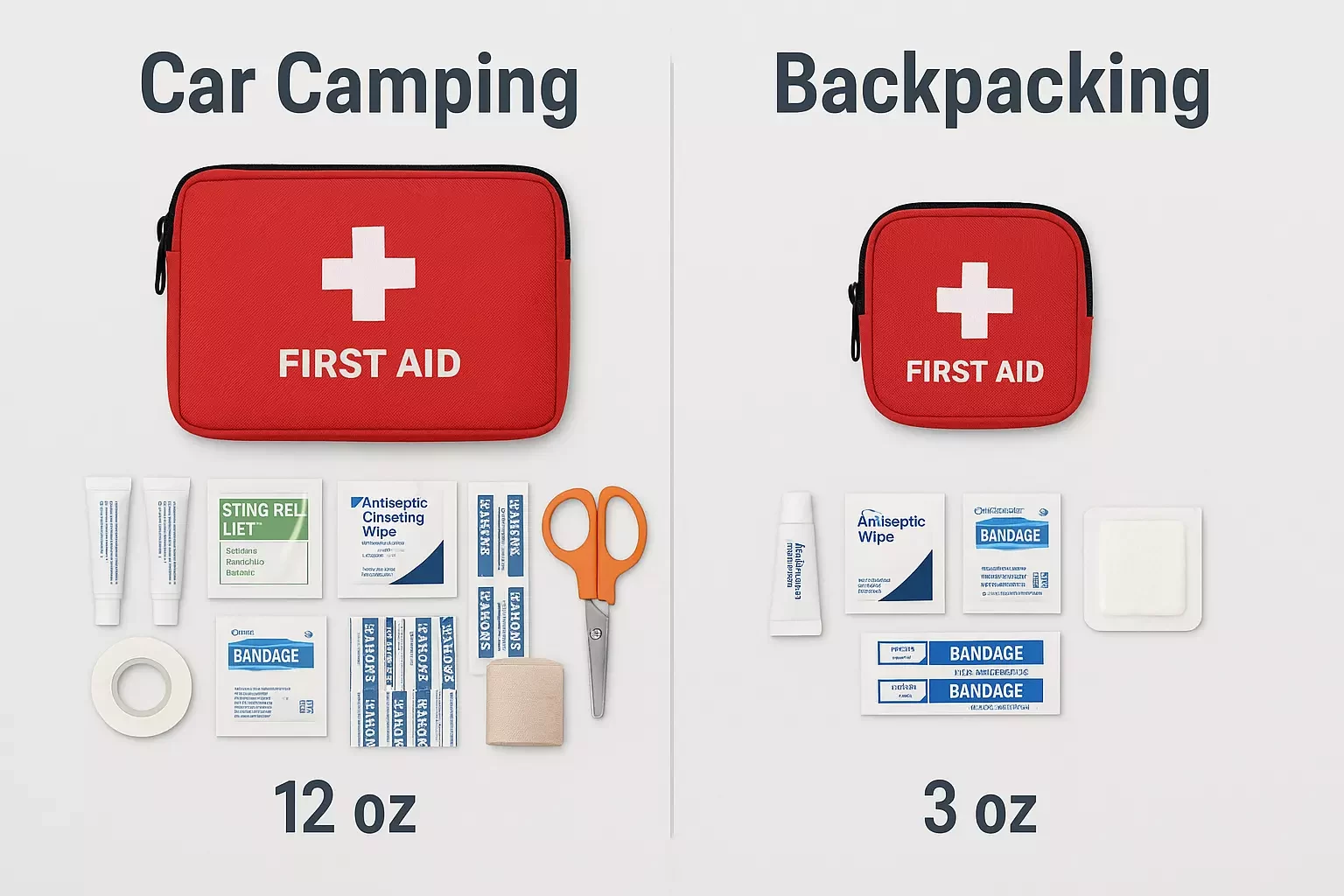
Container Selection
Waterproof Storage:
Choose containers that protect supplies from moisture while remaining easily accessible. Options include:
- Hard-shell waterproof cases
- Ziplock bags within a main container
- Dry bags for soft storage
- Clear containers for easy identification
Labeling and Organization
Color-Coded System:
- Red: Emergency and trauma supplies
- Blue: Medications
- Green: Wound care
- Yellow: Tools and accessories
Quick Access Priorities:
Place frequently used items (bandages, pain relievers) in easily accessible compartments. Emergency items should be clearly marked and quickly identifiable, even in low-light conditions.
🏕️ Camping First Aid Kit Builder
Select Your Trip Type:
📊 Kit Summary
Selected Items: 0
Estimated Weight: 0.0 oz
Trip Suitability: Select items to see feedback
Special Considerations for Different Environments
Cold Weather Camping
Winter camping presents unique medical challenges that require additional preparation:
Cold-Related Injuries:
- Hand and foot warmers
- Extra insulation materials
- Thermometer capable of reading low temperatures
- Knowledge of hypothermia and frostbite treatment
When planning cold weather adventures, proper clothing selection becomes a medical consideration. Learn about cool weather clothes for camping to prevent cold-related emergencies.
Hot Climate Considerations
Heat-Related Illness Prevention:
- Extra electrolyte supplements
- Cooling towels or bandanas
- Sunscreen (SPF 30 or higher)
- Insect repellent with DEET
Hydration Support:
Understanding how to purify water for drinking while camping becomes crucial for preventing dehydration and waterborne illnesses in hot climates.
High-Altitude Camping
Altitude Sickness Preparation:
- Acetazolamide (prescription required)
- Pulse oximeter for monitoring
- Extra fluids and electrolytes
- Descent plan for severe symptoms
Maintenance and Kit Management
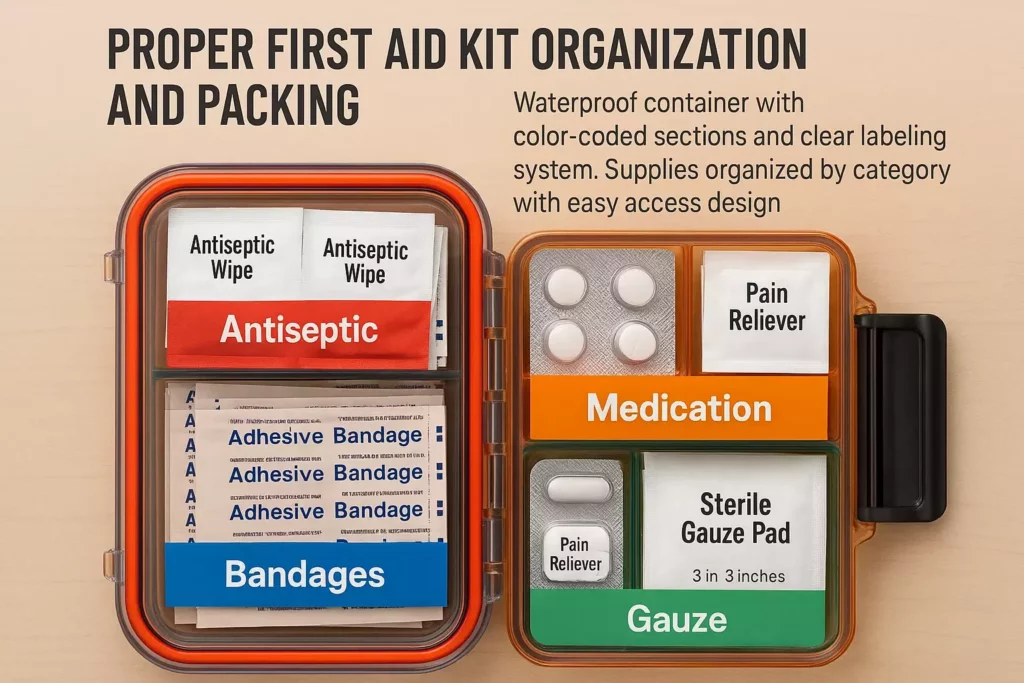
Regular Inspection Schedule
Monthly Checks:
- Verify medication expiration dates
- Replace used supplies
- Check container integrity
- Update emergency contact information
Pre-Trip Inspection:
- Confirm all essential items present
- Check quantities based on group size
- Verify special medications for participants
- Test electronic devices (thermometer, etc.)
Expiration Management
Medication Rotation:
Create a simple tracking system for medication expiration dates. Replace items 6 months before expiration to ensure effectiveness during emergencies.
Supply Refresh:
- Adhesive items lose stickiness over time
- Antiseptic wipes dry out
- Elastic bandages lose elasticity
- Replace annually or after heavy use
Documentation and Training
Emergency Information Card:
Include laminated cards with:
- Emergency contact numbers
- Medical conditions of group members
- Allergies and current medications
- Basic treatment protocols
Skill Development:
Having supplies without knowledge limits effectiveness. Consider taking basic first aid and CPR courses. Practice using your kit components before emergencies arise.
Building Skills Alongside Your Kit
Essential First Aid Knowledge
Basic Life Support:
- CPR techniques
- Choking response
- Shock treatment
- Bleeding control
Common Camping Injuries:
- Burn treatment from campfires
- Sprain and strain management
- Wound cleaning and dressing
- Recognizing serious injuries requiring evacuation
Emergency Response Planning
Communication Strategy:
- Satellite communicators for remote areas
- Cell phone backup batteries
- Emergency whistle protocols
- Signal mirror techniques
Evacuation Planning:
Know your location and nearest medical facilities. Carry maps and GPS coordinates for emergency responders. Understand when to attempt self-rescue versus waiting for help.
Advanced Kit Considerations
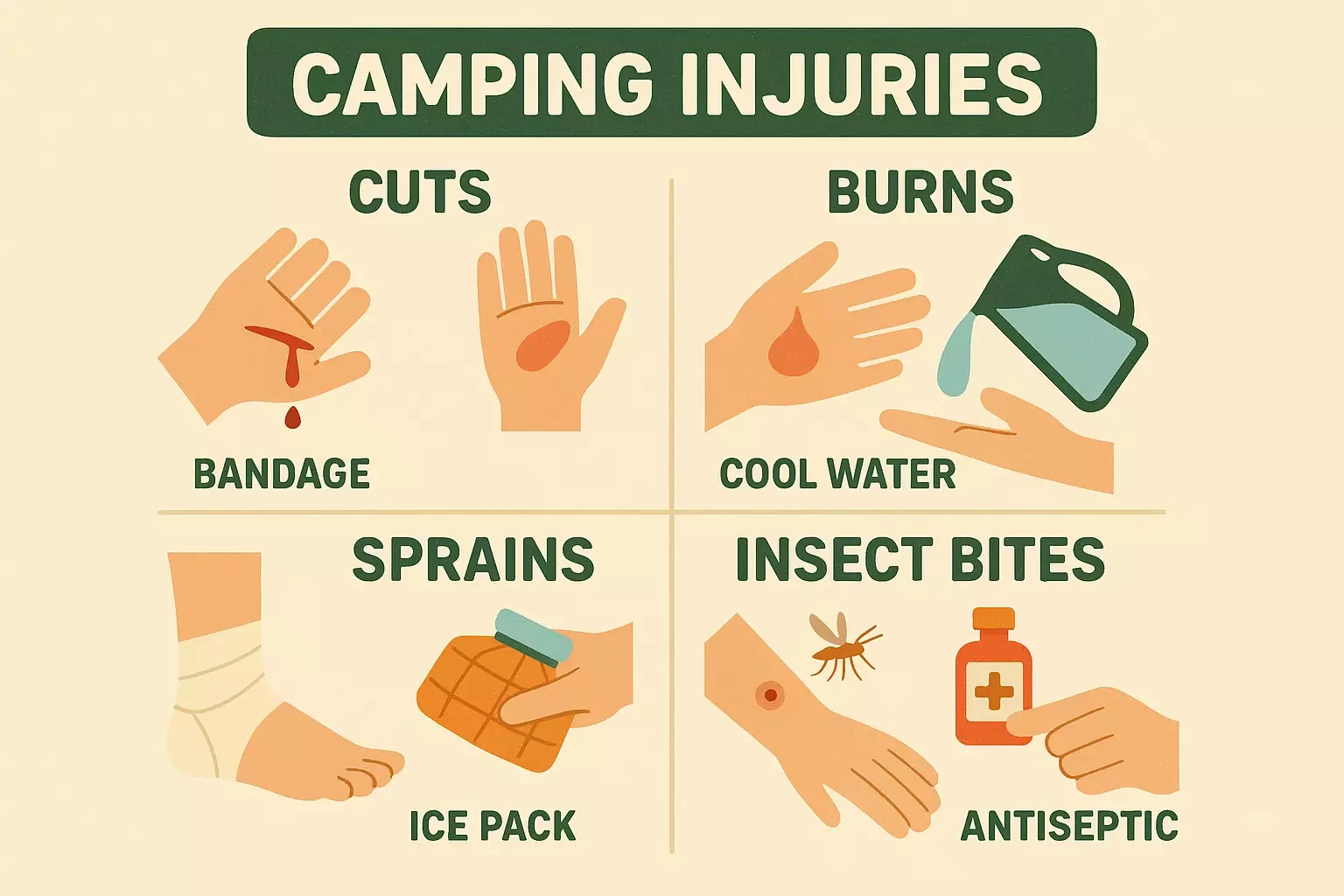
Prescription Medications
Personal Medications:
Ensure adequate supplies for trip duration plus extra days. Carry medications in original containers with clear labeling. Include a list of medications and dosages for emergency responders.
Group Medical Needs:
Survey group members for medical conditions, allergies, and current medications. Consider carrying emergency medications for common conditions like severe allergic reactions or heart conditions.
Specialized Equipment
Trauma Supplies for Remote Areas:
- Israeli bandages for severe bleeding
- Chest seal for puncture wounds
- Splinting materials
- Emergency sutures (with training)
Environmental Hazards:
- Snake bite kits for appropriate regions
- Poison ivy treatment
- Tick removal tools
- Bear spray (where appropriate)
When venturing into areas requiring specialized survival skills, consider complementing your first aid kit with a bushcraft survival kit for camping to address broader emergency scenarios.
Integration with Overall Camping Preparation
Coordinating with Other Safety Gear
Your first aid kit works best as part of a comprehensive safety system. When setting up camp, especially for first-time campers learning about tent setup and camp organization, consider first aid kit placement for quick access.
Family Camping Adaptations
Families need special consideration for first aid preparation. Beyond standard supplies, include:
Child-Specific Items:
- Children’s medications (appropriate dosages)
- Thermometer strips for quick temperature checks
- Extra comfort items for treating scared children
- Child-safe antiseptic options
Planning activities for kids while camping should include safety briefings about first aid kit location and basic injury response.
Weight Distribution for Group Camping
Shared Responsibility:
Distribute first aid supplies among group members to prevent total loss if one pack is damaged or lost. Ensure multiple people know first aid kit locations and contents.
Redundancy Planning:
- Multiple people carry basic supplies
- Backup medications for critical needs
- Distributed emergency communication devices
- Shared knowledge of emergency procedures
Cost-Effective Kit Building
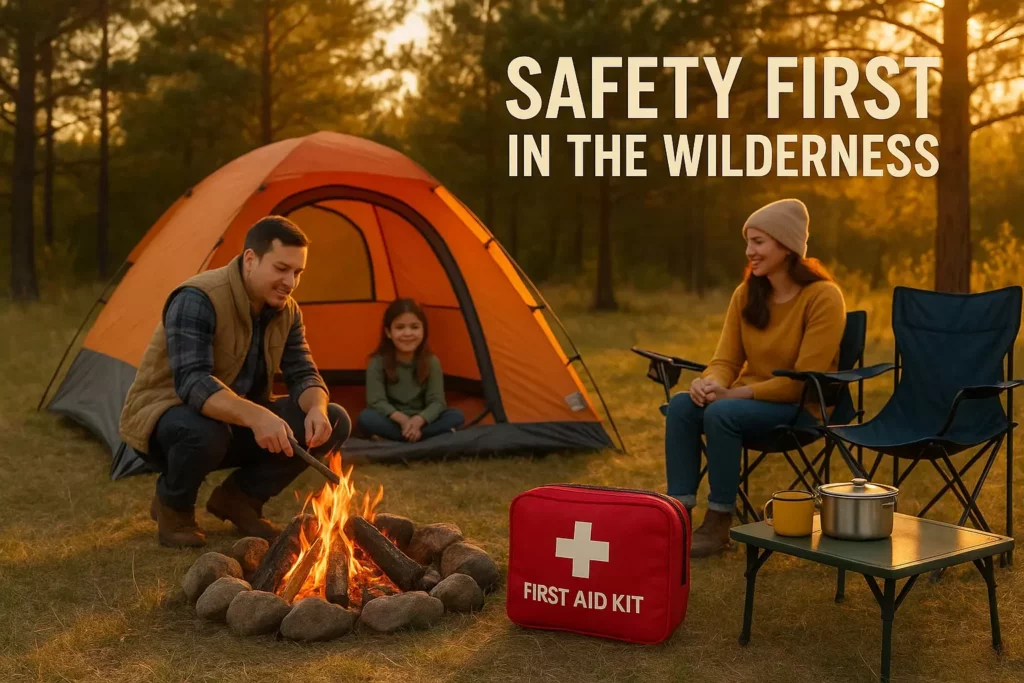
Budget-Friendly Strategies
Gradual Assembly:
Build your kit over time, purchasing items during sales or when replacing household first aid supplies. Focus on essential items first, then add specialized equipment as budget allows.
Generic vs. Brand Name:
Many generic medications and supplies offer the same effectiveness at lower costs. Focus spending on quality items like scissors, thermometers, and containers that affect functionality.
DIY vs. Pre-Made Kits
Starting with Pre-Made Kits:
Commercial first aid kits provide a foundation but usually require supplementation. They’re convenient for beginners but may lack camping-specific items.
Custom Assembly Benefits:
- Choose quality components
- Customize for specific needs
- Better understanding of contents
- Cost savings on bulk purchases
Technology Integration
Digital Resources
Smartphone Apps:
Download offline first aid reference apps before heading to areas without cell service. Include emergency contact information and medical history in easily accessible formats.
GPS and Communication:
Modern emergency communication devices can dramatically improve rescue response times. Consider satellite messengers for remote camping areas.
Traditional Backup Methods
Paper Documentation:
Always carry paper backups of critical information. Electronic devices fail, batteries die, and screens break. Waterproof, laminated cards ensure access to vital information.
Conclusion
Building an effective camping first aid kit requires thoughtful consideration of your specific needs, camping style, and skill level. The difference between a basic bandage collection and a comprehensive medical kit can literally be life-saving in remote outdoor environments.
Start with the essential items outlined in this guide, then customize based on your camping preferences and group requirements. Remember that having the right supplies is only half the equation – developing the skills to use them effectively completes your emergency preparedness.
Take Action Today:
- Assess your current first aid supplies and identify gaps based on your camping style
- Create a shopping list prioritizing essential items first, then specialized equipment
- Schedule first aid training to build confidence in using your kit effectively
- Practice scenarios with your camping group to ensure everyone knows kit locations and basic procedures
- Set calendar reminders for regular kit maintenance and supply rotation
Your safety and that of your fellow campers depends on preparation that happens long before you reach the trailhead. Invest in quality supplies, develop essential skills, and maintain your kit regularly. The wilderness offers incredible experiences, but being prepared for medical emergencies ensures those experiences remain positive memories rather than cautionary tales.
For comprehensive guidance on outdoor safety and preparation, explore our complete guide to building your first aid kit which covers both camping and general outdoor activities.

